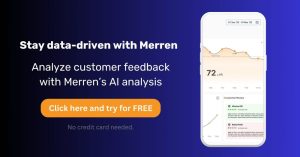Customer feedback is an ongoing process. However, analyzing this feedback and customer data is just as important. A feedback is a window to a user’s thought process about the dynamic market. Every communication strategy and product development is done on the basis of what people share, think and feel. In this blog, we will share how to do a customer feedback analysis of both qualitative and quantitative data. We will also tell our readers the new-age role of AI for the customer experience industry.
Types of Customer Feedback Data Formats
Customer feedback can come in several formats. Let’s break them down:
1. Quantitative or structured data
Quantitative data is numerical or categorized and is easy to measure and compare.
Numerical data: These are numeric values representing ratings or scores.
Example: Customer satisfaction ratings (15 stars), Net Promoter Score (NPS) or Customer Effort Score (CES).
Yes/No responses: Binary responses are quick to gather and straightforward to analyze.
Example: “Would you recommend this product? Yes/No.”
Multiple choice: Predefined options where customers select their responses.
Example: “Which feature do you use most? [Feature A, Feature B, Feature C].”
2. Qualitative or unstructured data
Qualitative data contains a customer’s opinions and emotions.
Open-Ended text responses: Customers provide detailed feedback in their own words. It is mostly an option after they have shared numeric based responses.
Example: “Please share the reason for your ratings:”
Voice/audio feedback: Voice recordings or voice surveys via chatbots of WhatsApp surveys.
Example: Seeking voice response using voice note feature of messenger apps.
Video feedback: Customers may submit videos sharing their product experience.
Example: Digital diaries, video features on survey apps or YouTube reviews.
3. Categorical data
Categorical data captures consumer demographics and preferences driven by behaviour.
Demographic information: Data related to age, gender, income levels or location.
Example: “What is your age group?”
Behavioral categories: Data reflecting customer behaviors or habits.
Example: “How often do you use this product? [Daily, Weekly, Monthly].”
4. Time series data
This type of data tracks feedback over specific time periods or events.
Event based data: This is an in-moment survey based on a particular interaction or touchpoint.
Example: post purchase survey or in-app survey after a transaction.
5. Ranked or ordinal data
Ordinal data ranks preferences or items based on priority.
Ranking questions: Customers rank features or services in order of importance.
Example: “Rank these features from most important to least important.”

How to Analyze Customer Feedback?
Once you collect respondent feedback via various mediums, the next step is to analyze it effectively. Different data formats require specific methods of analysis.
1. Quantitative data (structured)
Assessing numerical data (e.g., rating scales, scores):
Use descriptive statistics such as mean, median, and standard deviation to analyze.
Example: Calculate the average NPS or satisfaction score. You can visualize using bar charts, line graphs, pie charts and histograms.
Analyzing Yes/No responses:
Calculate the percentage of “Yes” or “No” responses. For example, “80% of customers would recommend this product.”
Multiple choice analysis:
Count the frequency of selections to understand preferences. For example, “Feature A was chosen by 60% of customers.”
2. Qualitative data (unstructured)
Qualitative data also needs manual intervention to assess and identify people’s emotional metrics. Apart from technological intervention, manual assessment can help professionals gauge certain metrics that are not too obvious using tools.
Open-Ended text responses:
Use thematic analysis to find recurring patterns or employ Natural Language Processing (NLP) for sentiment analysis. Word cloud segmentation can detect common themes and words related to product features. Example, “difficult returns”, “security lock systems”, “fast shipping” etc. You can obtain data on sentiment graphs and word clouds.
Voice/audio feedback:
Transcribe audio using speech-to-text analysis and detect emotions. There are tools that can segment emotions based on positive, neutral or negative. Recorded calls can identify frustration metrics over non-support or long wait times in support calls.
3. Categorical data
Demographic information:
Professionals can analyze demographic responses by segmenting feedback as per patterns and trends. For Eeample: “Younger customers rate the product higher than older customers.”. You can view the results on bar charts filtered as per the segmentation metrics (age groups, income levels etc)
Behavioral categories:
Assess feedback based on behaviour and preferences. For example, “ 80% of daily users are more satisfied than weekly users.” The charts will be segregated on the number of people divided between daily and weekly usage patterns.
4. Time series data
This data is analyzed based on an event and occurrence. The method is to track feedback trends using time series analysis. For example, “CSAT scores increased by 15% after a software update.” Heat maps are a good way to detect friction points, frustration metrics and page refresh speed etc depending on the software and application. Use this data to offer better upgrades and assistance.
5. Ranked or Ordinal data
Use the median or mode to summarize rankings, or perform ordinal regression for deeper insights. For example: “Feature A is ranked most important.”. View a unified version of the responses using bar charts or ranked lists in order or importance.
Leveraging AI for Customer Feedback Analysis
Artificial intelligence is making it easier for CX professionals to congregate and collate data in a simplified format. This is easier for a day to day assessment. When businesses go global, AI integration is necessary to cater to a fast-moving consumer base. However, to keep up with the competitive stance, AI can be your right hand man.
1. Sentiment analysis
AI-powered NLP can analyze text, audio, or video feedback to determine customer sentiment—whether it’s positive, negative, or neutral. The benefit here is that it is fast and accurate in a few clicks. It can gauge multiple reviews and assess satisfaction trends and track changes over time.
2. Text classification (supervised learning)
AI models classify feedback into predefined categories (e.g., complaints, praises, or suggestions). This is useful to sort out and route consumer feedback to relevant departments as they roll in. Avoid manual and batch processing of data to obtain faster responses. However, in real time, this process happens quickly. Most people expect instant resolutions or within 24 hours.
3. Speech recognition and emotional analysis in voice feedback
AI converts voice recordings into text and analyzes them for sentiment, tone, or intent. AI learnings can identify patterns of dissatisfaction related to long wait times (or other friction points). You can obtain emotional metrics of either frustration, sadness or satisfaction.
4. Predictive analytics
AI uses past feedback data to predict future customer behavior, such as churn or loyalty. It can predict which customers are likely to churn based on their feedback history. This will help CX teams to spring into action and take necessary strategies to prevent this event. For example, AI forecasts that customers who gave low ratings are 80% likely to churn within a month. However, if you want to be sure about your data, AI can revisit past history. This includes the following- support tickets raised, customer’s past ratings, product value purchased and usage history, current open-issues.
5. Customer feedback segmentation
AI can automatically segment customers by demographics or behavior based on their feedback patterns. One can personalize marketing campaigns or customer service responses based on segment insights. Net promoter scores are segmented into detractors, passives and promoters. Promoters are happy people, detractors are unhappy consumers and passives lean on to neither side. There are formulas to segment responses based on each satisfaction metric scale. CSAT and CES scores have their own individual formula to assess feedback results.
6. Recommendation systems for customer support
AI suggests potential solutions to common customer problems based on historical feedback data. It can provide automated troubleshooting suggestions for common issues. All suggestions are based on past records.
7. Real time customer feedback analysis
Artificial intelligence is slowly becoming the go-to method to capture real time consumer feedback. Real time is the key to a successful customer experience and problem resolution. Industries like ecommerce, FMCG or retail thrive on real time assessment of issues. The competition is high in these industries. For example, if you have received a wrong product, the user might want to get in touch with the support team via a live chat swiftly.
Conclusion
In today’s data-driven world, collecting and analyzing customer feedback is critical for improving the customer experience. Identify different data formats and leverage AI for analysis. Find the right tools that can minimize the workload so that businesses can allocate resources more efficiently. Stay data-driven with Merren. Capture responses first hand and let our AI do the heavy lifting. Sign up for a 14 day free trial and get access to all the features. Stay locked in with your data with Merren.

